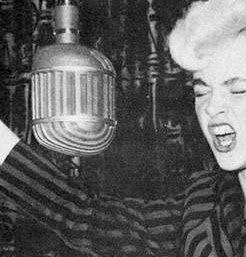When we hear a record of a woman rocking and rolling in the fifties, it is often tempting to ascribe “wild” vocal qualities like screaming, shouting, and growling to a sense of personal empowerment or daring. Conversely, smoother vocalizing is associated with restraint and repression. But is that always the case?
By the 1950s, there was a body of scientific and pseudo-scientific research claiming that voice and personality were inextricably linked. One expert, Paul J. Moses—who published widely in the post-World War II era—claimed that he could diagnose neurosis simply by hearing a recording of the patient’s voice, which he would analyze for qualities like pitch, pathos, speed, melody, respiration, “rhythmical prevalence,” and glissando. Women were thought of as particularly susceptible to showing tension or neurosis in their voices, because their higher tessitura could lead to audible shrillness. Moses identified the vocal chords as a secondary sex organ, therefore susceptible to sexual frustration. “The frustrated female voice,” he notes, “is a widespread symptom in contemporary Western cultures.” 1 The more “glissando,” or instability, a woman had in her voice, the more neurotic she was believed to be.
Ideas about female and effeminate voices also emerged in the popular press, where they infiltrated books on voice training and manuals on health, hygiene, and etiquette—many of which were aimed at teenage girls. The Guide to Good Grooming for Negro Girls (1959), for example, offers that “the girl most likely to succeed . . . is the girl with a voice that is as feminine and charming as the girl herself (or the girl she is trying to be).”2 Girls were told that their voices were an important means of attracting a husband—and, conversely, that poor vocal habits could repel members of the opposite sex. These guides counseled women to record their voices so that they might hear and correct their own flaws. Singers were also cautioned to consider what factors made their voices most alluring. “What’s sexy?” actress Dorothy Uris asked women in her book Everybody’s Book of Better Speaking. “Not those raucous ‘singing’ voices that raise the pulse beat of rabid record buyers.”3
Whether or not it was a direct consequence of this kind of advice about what constituted a healthy or sexy voice for women, some female rock and rollers did not like the idea of growling and screaming on their records—at least not all the time.
Women Rock & Rollers on Growling and Screaming
Laura Lee Perkins
As Laura Lee Perkins recalled of her sessions, “They [meaning Imperial Records] gave me some songs to listen to . . . and I had to listen to those and try and learn the words. And then I went back to the studio the next day, and had to perform these songs that I didn’t know, and didn’t like! I hated the songs, and they also wanted me to growl my voice, and I didn’t like that.” “Kiss Me Baby” (1958) demonstrates the result, which has so many growls as to sound forced:
Sparkle Moore
Sparkle Moore tells a similar story about her experience with Cincinnati-based Fraternity Records. She described her sessions as “strange, and slightly disappointing, in the sense that I had no control of [the] sound. I wasn’t accustomed to playing with an older established orchestra. I felt uncomfortable and thought the music didn’t sound right. I wanted a lot of echo, etc., which never happened. The music wasn’t loose enough I thought.” Some of this discomfort is apparent in her voice in alternate takes from these sessions made available by Ace Records, in which a producer can be heard asking her to “scream.”
The takes with the screams were not used for the final release.
Wanda Jackson
In an interview with Holly George-Warren, Wanda Jackson recalled both coming into this sound on her own, but while taking direction from both Capitol Records’s Ken Nelson and her father, who acted as her manager while recording “Fujiyama Mama”:
I didn’t really know . . . what tempo I wanted it; what key would be best—you can move them a little, it makes a big difference in the sound—so [Ken Nelson] was having me do that. And finally we settled in. And then he [Nelson] was still wanting something. And Daddy could see—Daddy was in the control room—he could see I was getting frustrated and confused. And he called a break, or told Ken “just a minute.” He came in the studio, and pulled me aside. And Daddy never had to say much. He was a man of few words, and pretty quiet spoken. But he said, “Wanda, You rear back. And you sing that song however you want to sing it.” I said, “Okay! If Daddy said it.” I’m really not that young any more, but I depended a lot on what he said and what he thought about things. So I went back and I started and—that growl just came out like that. You know it was kind of—it kind of amazed me. 4
Wanda Jackson’s growl is so famous she is sometimes referred to as the “nice lady with the nasty voice,” and she has continued using it in her rockabilly singing into her eighties.
- Paul J. Moses, The Voice of Neurosis (New York: Grune and Stratton, 1954) 38, 111.
- Elsie Archer, Let’s Face It: A Guide to Good Grooming for Negro Girls (Philadelphia: J. B. Lippincott, 1959),157.
- Uris, Everybody’s Book of Better Speaking (New York: David McKay, 1960), 98.
- Wanda Jackson, oral history interview with Holly George-Warren (recorded in December of 2011) in the collection of the Rock and Roll Hall of Fame and Museum’s Library and Archives.

